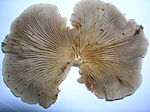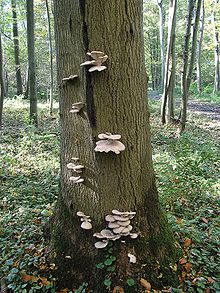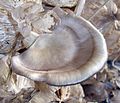- Pleurotus ostreatus
-
Pleurotus ostreatus 
Oyster mushroom in the Havré wood, Belgium Scientific classification Kingdom: Fungi Phylum: Basidiomycota Class: Agaricomycetes Order: Agaricales Family: Tricholomataceae Genus: Pleurotus Species: P. ostreatus Binomial name Pleurotus ostreatus
(Jacq. ex Fr.) P.Kumm. 1871[1]Pleurotus ostreatus Mycological characteristics 
gills on hymenium 
cap is offset 
hymenium is decurrent 
stipe is bare 
spore print is white 
ecology is saprotrophic 
edibility: choice Pleurotus ostreatus, the oyster mushroom, is a common edible mushroom. It was first cultivated in Germany as a subsistence measure during World War I[2] and is now grown commercially around the world for food. However, the first documented cultivation was by Kaufert[3] There is some question about the name Pleurotus corticatus, but no question he cultivated an oyster mushroom. It is related to the similarly cultivated "king oyster mushroom". Oyster mushrooms can also be used industrially for mycoremediation purposes. The oyster mushroom may be considered a medicinal mushroom, since it contains statins such as lovastatin which work to reduce cholesterol.[4]
Contents
Name
Both the Latin and common names refer to the shape of the fruiting body. The Latin pleurotus (sideways) refers to the sideways growth of the stem with respect to the cap, while the Latin ostreatus (and the English common name, oyster) refers to the shape of the cap which resembles the bivalve of the same name. Many also believe that the name is fitting due to a flavor resemblance to oysters.
In Chinese, they are called píng gū (平菇; literally "flat mushroom"). In Vietnam, the mushroom is known as nấm sò or nấm bào ngư.[clarification needed] It is called chippikkoon (ചിപ്പിക്കൂൺ) in Malayalam.
The oyster is one of the more commonly sought wild mushrooms, though it can also be cultivated on straw and other media. It often has the scent of anise due to the presence of benzaldehyde (which, however, smells more like almonds).[5]
Description
The mushroom has a broad, fan or oyster-shaped cap spanning 5–25 cm; natural specimens range from white to gray or tan to dark-brown; the margin is inrolled when young, and is smooth and often somewhat lobed or wavy. The flesh is white, firm, and varies in thickness due to stipe arrangement. The gills of the mushroom are white to cream, and descend on the stalk if present. If so, the stipe is off-center with a lateral attachment to wood. The spore print of the mushroom is white to lilac-gray, and best viewed on dark background. The mushroom's stipe is often absent. When present, it is short and thick.
Omphalotus nidiformis is a toxic lookalike found in Australia and Japan. In North America, Omphalotus olivascens, the western jack-o'-lantern mushroom and Clitocybe dealbata, the ivory funnel mushroom, both bear a resemblance to Pleurotus ostreatus. Both Omphalotus olivascens and Clitocybe dealbata contain muscarine and are toxic.
Habitat
The oyster mushroom is widespread in many temperate and subtropical forests throughout the world, although it is absent from the Pacific Northwest of North America, being replaced by P. pulmonarius and P. populinus.[6] It is a saprotroph that acts as a primary decomposer of wood, especially deciduous trees, and beech trees in particular.[7] It is a white-rot wood-decay fungus.
The oyster mushroom is one of the few known carnivorous mushrooms. Its mycelia can kill and digest nematodes, which is believed to be a way in which the mushroom obtains nitrogen.
The standard oyster mushroom can grow in many places, but some other related species, such as the branched oyster mushroom, grow only on trees.
Culinary uses
The oyster mushroom is frequently used in Japanese, Korean and Chinese cookery as a delicacy: it is frequently served on its own as soup, sometimes stuffed, or in stir-fry recipes with soy sauce. Oyster mushrooms are sometimes made into a sauce, used in Asian cooking, which is similar to oyster sauce. The mushroom's taste has been described as a mild with a slight odor similar to anise. The oyster mushroom is best when picked young; as the mushroom ages, the flesh becomes tough and the flavor becomes acrid and unpleasant.
Oysters mushrooms are widely cultivated and used in Kerala, India; a wide variety of dishes are prepared from them. Oysters mushrooms are mainly cultivated in large clear polythene bags with buns of hay layered in the bags, and spores sown between these layers.
Oyster mushrooms contain small amounts of arabitol, a sugar alcohol, which may cause gastrointestinal upset in some people.
Non-culinary uses
A US company, Ecovactive Design, has proposed using the mycelium along with the growing substrate as a substitute for petroleum derived expanded polystyrene packing material or as an insulating material.[8] It may also be used to absorb and digest oil spills and other petroleum products.
Oyster mushrooms and lovastatin
In vivo research has shown that consumption of oyster mushrooms lowers cholesterol levels,[9] because these mushrooms naturally contain lovastatin.[4] Studies have shown they contain up to 2.8% lovastatin on a dry weight basis.[10]
Gallery
See also
References
- ^ Kummer, P. (1871). Der Führer in die Pilzkunde (1st ed.).
- ^ Eger, G., Eden, G. & Wissig,E. (1976).Pleurotus ostreatus — breeding potential of a new cultivated mushroom. Theoretical and Applied Genetics 47: 155-163.
- ^ Kaufert, F. (1936) The biology of Pleurotus corticatus Fries. Minnesota Agricultural Experiment Station Bulletin 114.
- ^ a b Gunde-Cimerman N, Cimerman A. (Mar 1995). "Pleurotus fruiting bodies contain the inhibitor of 3-hydroxy-3-methylglutaryl-coenzyme A reductase-lovastatin.". Exp Mycol. 19 (1): 1–6. doi:10.1006/emyc.1995.1001. PMID 7614366.
- ^ Beltran-Garcia, Miguel J.; Estarron-Espinosa, Mirna; Ogura, Tetsuya (1997). "Volatile Compounds Secreted by the Oyster Mushroom (Pleurotus ostreatus)and Their Antibacterial Activities". Journal of Agricultural and Food Chemistry 45: 4049. doi:10.1021/jf960876i. http://pubs.acs.org/doi/abs/10.1021/jf960876i.
- ^ Trudell, S.; Ammirati, J. (2009). Mushrooms of the Pacific Northwest. Timber Press Field Guides. Portland, Oregon: Timber Press. p. 134. ISBN 0-88192-935-2.
- ^ Phillips, Roger (2006), Mushrooms. Pub. McMilan, ISBN 0-330-44237-6. P. 266.
- ^ http://www.thisoldhouse.com/toh/article/0,,20153687,00.html
- ^ Rop O, Mlcek J, Jurikova T. (2009). "Beta-glucans in higher fungi and their health effects". Nutrition Reviews 67 (11): 624–31. doi:10.1111/j.1753-4887.2009.00230.x. PMID 19906249.
- ^ . http://www.znaturforsch.com/ac/v58c/s58c0062.pdf.
- [Edible and Medicinal Mushrooms of New England and Eastern Canada] (2009) ISBN: 978-1-55643-795-3
- Stamets & Chilton, The Mushroom Cultivator, 1983
- Stamets, Growing Gourmet and Medicinal Mushrooms (Third Edition), 2000
- National Audubon Society Field Guide to North American Mushrooms, 1997
External links
- Pleurotus ostreatus in Index Fungorum.
- Pleurotus ostreatus in MycoBank.
- Mushroom-Collecting.com - Oyster mushrooms
- Bobek P, Ozdín L, Kuniak L (August 1996). "Effect of oyster mushroom (Pleurotus Ostreatus) and its ethanolic extract in diet on absorption and turnover of cholesterol in hypercholesterolemic rat". Nahrung 40 (4): 222–4. doi:10.1002/food.19960400413. PMID 8810086.
- [1] Dried shiitake (Lentinulla edodes) and oyster (Pleurotus ostreatus) mushrooms as a good source of nutrient.
- Time-lapse video of oyster mushroom growing to maturity
- Sremac bukovaca
Categories:- Pleurotaceae
- Fungi of Europe
- Fungi of Chile
- Fungi in cultivation
- Edible fungi
- Carnivorous fungi
- Vietnamese ingredients
Wikimedia Foundation. 2010.










